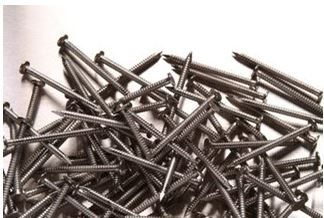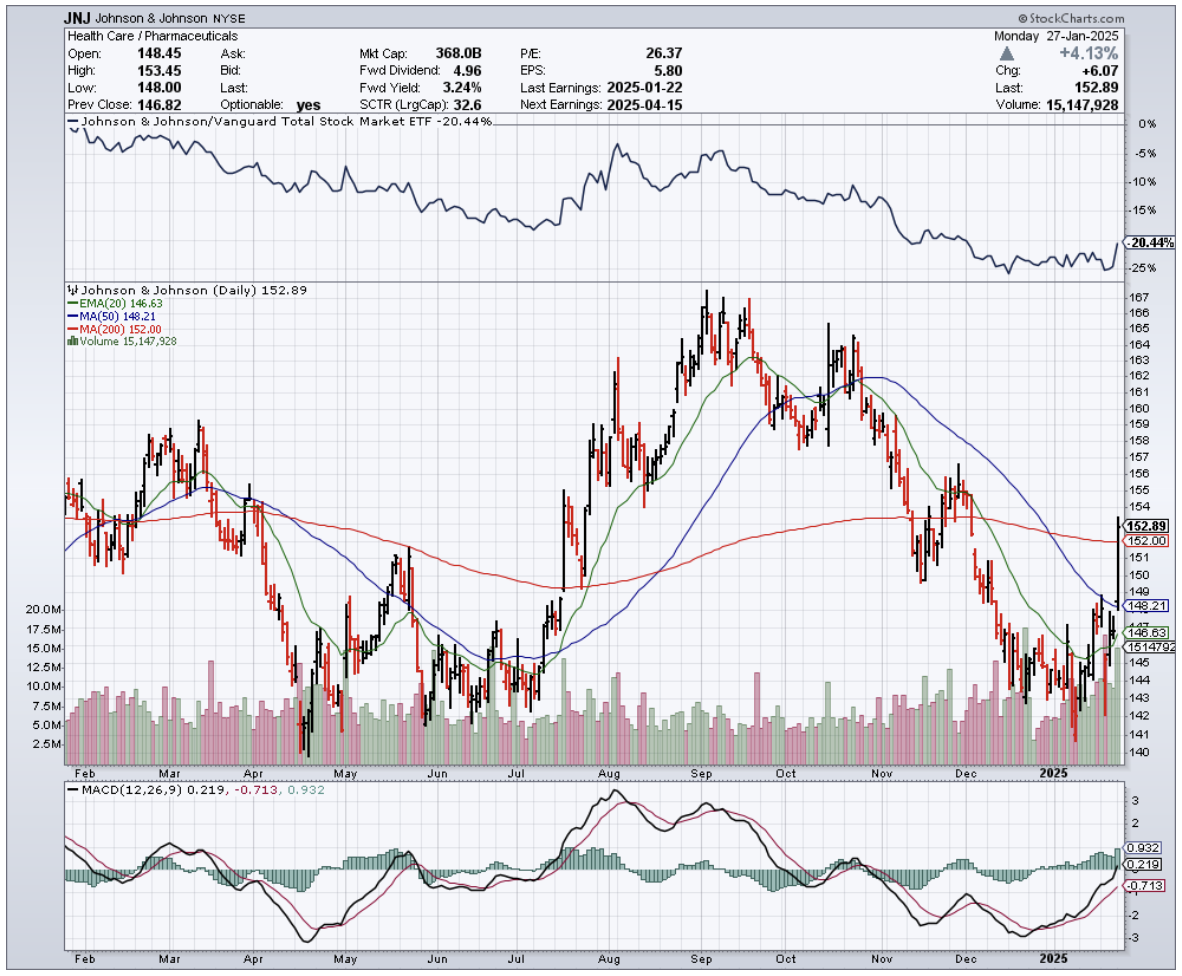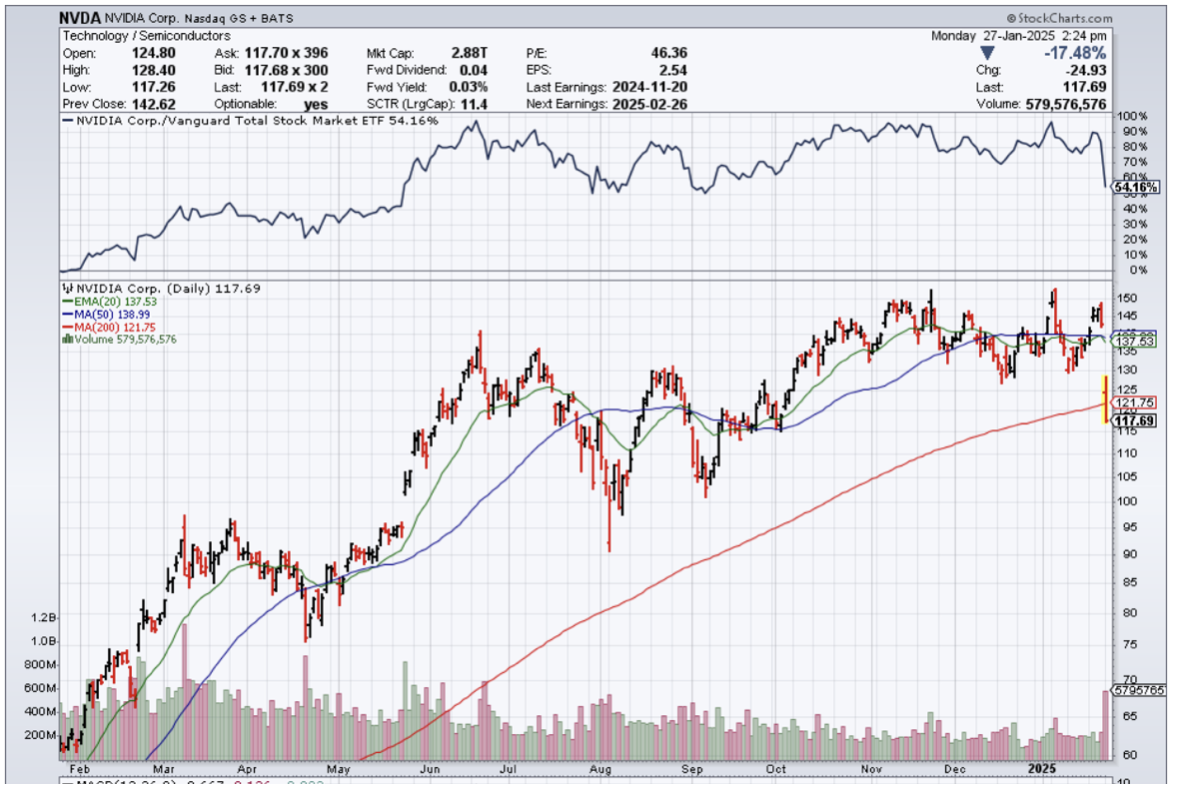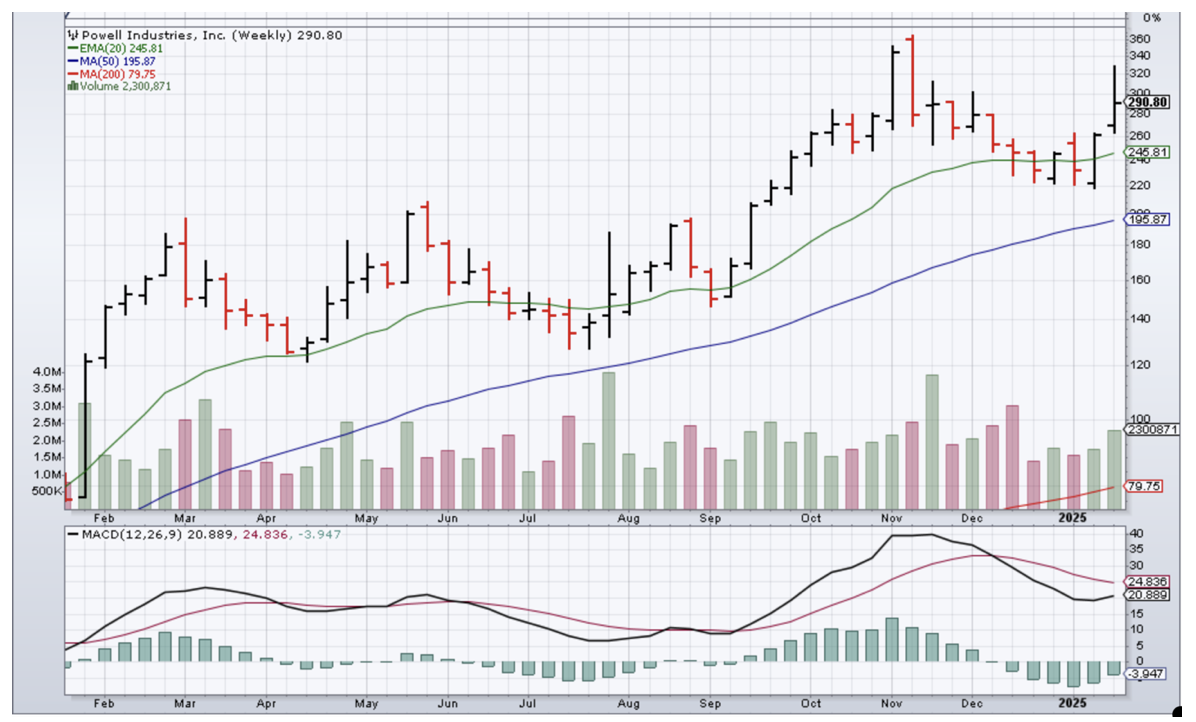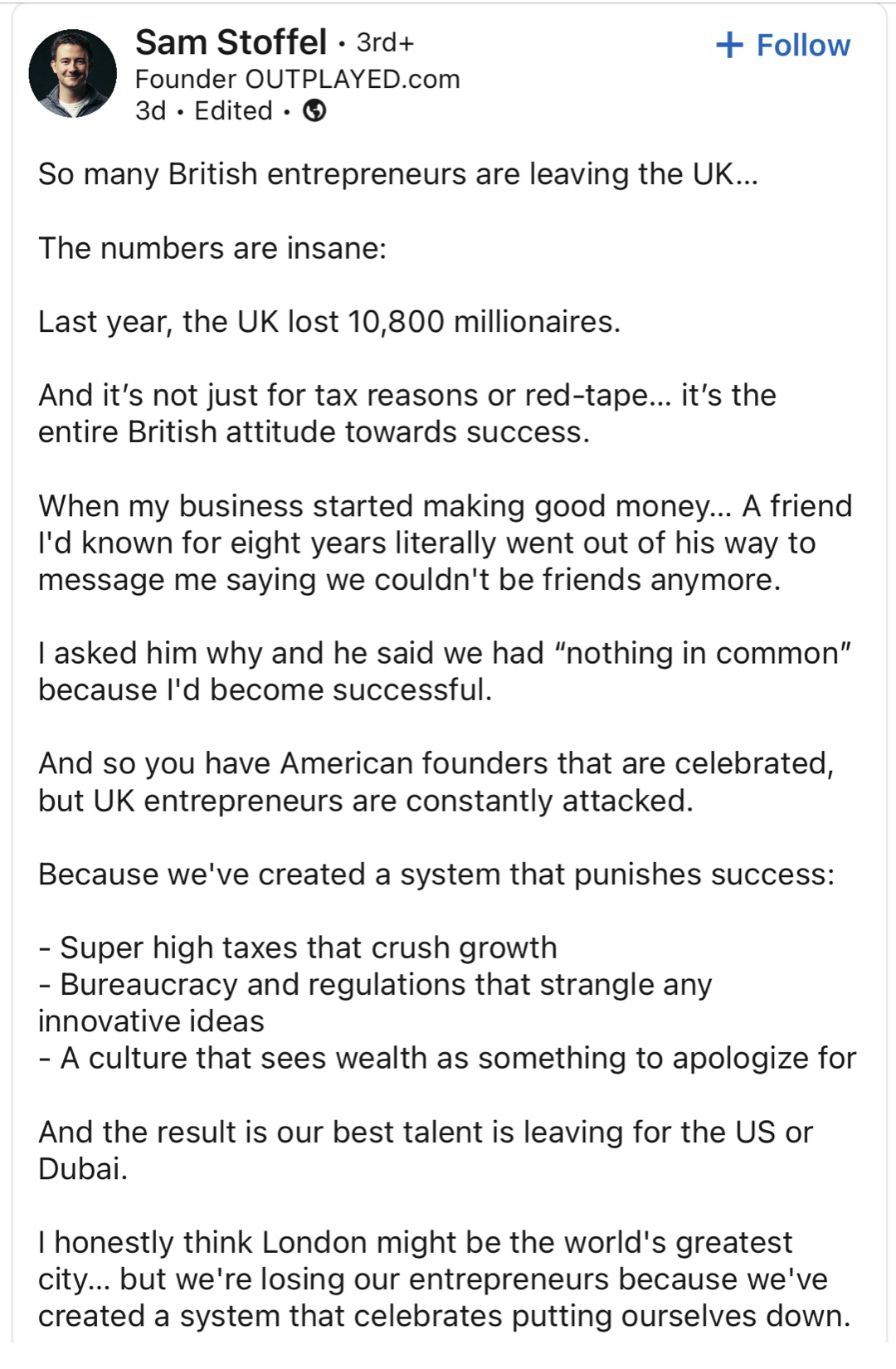“We have few, if any spare tires left,” said Mohamed El-Erian, CIO of mega bond house PIMCO, about the nail studded road ahead for the US economy.
When John identifies a strategic exit point, he will send you an alert with specific trade information as to what security to sell, when to sell it, and at what price. Most often, it will be to TAKE PROFITS, but, on rare occasions, it will be to exercise a STOP LOSS at a predetermined price to adhere to strict risk management discipline. Read more
When John identifies a strategic exit point, he will send you an alert with specific trade information as to what security to sell, when to sell it, and at what price. Most often, it will be to TAKE PROFITS, but, on rare occasions, it will be to exercise a STOP LOSS at a predetermined price to adhere to strict risk management discipline. Read more
Mad Hedge Biotech and Healthcare Letter
January 28, 2025
Fiat Lux
Featured Trade:
(READY, RESET, GO)
(JNJ), (AAPL), (PFE), (ABBV), (RHHBY), (AZN), (SNY), (NVS)
I had to laugh when I saw Johnson & Johnson's (JNJ) Q4 earnings hit my screen earlier this month.
Here we have Wall Street wringing its hands over a slight revenue miss, sending shares down 3.5%, while management is busy plotting its path to pharma industry dominance.
The numbers tell an interesting story.
Q4 revenues grew 5.3% (or 5.7% on an adjusted operational basis) to $22.5 billion. Wall Street got the vapors because earnings came in at $1.41 per share, well below their $2.04 consensus.
Reminds me of the time analysts completely missed Apple's (AAPL) transformation into a services company.
For the full year 2024, JNJ delivered 4.3% sales growth (5.4% operational) to $88.8 billion, with earnings per share landing at $5.79, or $9.98 adjusted after swallowing a $(0.67) hit from acquired IPR&D charges.
Not too shabby for a company in transition.
Looking into 2025, management is guiding for 2.5-3.5% operational sales growth ($90.9-91.7 billion) and adjusted operational EPS of $10.75-$10.95.
That's 8.7% growth at the midpoint, though they're careful to hedge around legal proceedings and acquisition costs.
And here's where it gets interesting.
During last week's JP Morgan Healthcare Conference, CEO Joaquin Duato was practically bouncing in his chair about their drug pipeline. Let's look at what's got him so excited.
Darzalex, their multiple myeloma superstar, raked in $11.67 billion in 2024, up 20%.
The new kid Carvykti exploded 93% higher to $963 million. Tecvayli landed $550 million in its rookie year.
Depression med Spravato jumped 56% to hit the magic $1 billion mark. Tremfya, their Stelara successor, grew 17% to $3.7 billion.
Speaking of Stelara – there's the elephant in the room.
JNJ's crown jewel is losing patent protection, already showing up in Europe with a >12% sequential decline in Q4 to $2.35 billion. Expect a 30% "haircut" this year.
But here's what Wall Street is missing: JNJ saw this coming years ago.
They just dropped $14.6 billion on Intracellular Therapies, mostly debt-funded (they can afford it with only $31.3 billion in long-term debt and $19.98 billion in cash).
This brings them Caplyta, an antipsychotic med with blockbuster potential that's already approved for schizophrenia and bipolar disorders.
The medical device business isn't sitting still either.
Q4 worldwide revenues jumped 6.7% year-on-year. While Surgery was flat at $2.5 billion and Orthopedics grew a modest 2.5% to $2.32 billion, Vision popped 9% to $1.3 billion.
But the real story? Cardiovascular surged 24% to $2.1 billion. Those Shockwave and Abiomed acquisitions are looking pretty smart right about now.
For the year, MedTech grew 4% to $31.56 billion. Operating margins slipped a bit – Innovative Medicines down from 42% to 39.4%, MedTech from 23.7% to 21.6%.
Late-stage pipeline products nearing approval should ease R&D expenses in 2025, just as JNJ gears up for its next growth phase.
The foundation looks rock solid - $19.98 billion in cash, $31.3 billion in long-term debt, 2025 adjusted EPS guidance of $10.75-$10.95, and that reliable $1.24 quarterly dividend.
But forget the current numbers - the real money's in what's coming next.
Here's what the market is missing: JNJ is promising 5-7% compound annual growth between 2025-2030, with ten drugs hitting $5+ billion in annual sales by decade's end.
Sound ambitious? Maybe. But they've got the pipeline to back it up – from immunology stars nipocalimab and icotrokinra to neuroscience contenders seltorexant and aticaprant, plus oncology plays like TAR-200 for bladder cancer.
I've seen this movie before with AbbVie (ABBV), which navigated the loss of $20+ billion Humira without missing a beat.
And JNJ looks even better positioned - their pharma division is targeting $58 billion in 2024 revenues, which would make them the biggest player in Big Pharma, ahead of Pfizer (PFE), AbbVie (ABBV), Roche (RHHBY), AstraZeneca (AZN), Sanofi (SNY) and Novartis (NVS).
The only real wildcard? That pesky talc litigation.
JNJ's latest move – spinning the lawsuits into Red River Talc LLC and filing for bankruptcy – could cap the damage at $8.5 billion. They claim 75% of claimants are on board, with a court ruling expected this month.
So, what's my take? I think JNJ's 2025 will be a "reset" year, especially the first half. But just like buying straw hats in winter, there might be an opportunity here for patient investors. Management says the back half will be stronger, setting up 2026 for what could be a very interesting guidance call.
While the market frets about Stelara's patent cliff, smart money is quietly building positions. That's why I'm maintaining my stand to buy the dip.
After all, sometimes the best trades are the ones that make you a bit uncomfortable at first. And if you're worried about patent cliffs, just ask any AbbVie shareholder how that worked out for them.
When John identifies a strategic exit point, he will send you an alert with specific trade information as to what security to sell, when to sell it, and at what price. Most often, it will be to TAKE PROFITS, but, on rare occasions, it will be to exercise a STOP LOSS at a predetermined price to adhere to strict risk management discipline. Read more
Global Market Comments
January 28, 2025
Fiat Lux
Featured Trade:
(THE NEW OFFSHORE CENTER: AMERICA),
(SIGN UP NOW FOR TEXT MESSAGING OF TRADE ALERTS)
Mad Hedge Technology Letter
January 27, 2025
Fiat Lux
Featured Trade:
(DEEPSEEK PUTS A SCARE INTO TECH STOCKS)
(CHINA), (NVDA)
The narrative that China is a decade behind in cutting-edge technology compared to Silicon Valley is total B.S. at this point.
It couldn’t be further from the truth.
First, it was the smartphone where Apple built an insurmountable lead for the Chinese.
Second, it was the EV and no Chinese company would ever surpass Tesla.
China is now leading in both EVs and smartphones at this point.
This narrative has been debunked and today is the final nail in the coffin.
Now…enter the wrath of artificial intelligence where reports indicate China has produced that aha moment in which China has managed to output the same quality of AI without Nvidia supercomputers and without a $100 million data centers.
Imagine the sigh of relief from American households that won’t have to deliver an electricity wealth transfer to Silicon Valley.
If this holds true, the Chinese have played the CEO of ChatGPT Sam Altman like a fiddle.
It’s extremely worrisome that Altman has irked Elon Musk so badly that it is widely known that Altman is Musk’s arch-enemy.
For everyone who doesn’t know, the app is called DeepSeek and it is now #1 in the Appstore.
Chinese artificial intelligence startup DeepSeek’s latest AI model sparked a multi-trillion rout in US and European technology stocks.
DeepSeek is a visible challenge to costlier models like OpenAI and raising suspicious if Sam Altman is just taking Silicon Valley on a ride for his gargantuan bank account.
Nvidia tanked 17% by mid-day and clearly would be one of the companies hurt by the Chinese.
DeepSeek shows that it is possible to develop powerful AI models that cost less and can potentially derail the investment case for the entire AI supply chain, which is driven by high spending from a small handful of hyperscalers.
The AI model from DeepSeek — founded by quant fund chief Liang Wenfeng — is widely seen as better than ChatGPT and will no doubt be a better value.
The DeepSeek product is deeply problematic for the thesis that the significant capital expenditure and operating expenses that Silicon Valley has incurred are the most appropriate way to approach the AI trend.
The DeepSeek release raises new doubts, challenging the notion that China’s AI technology is a decade behind US counterparts. Washington’s trade restrictions had kept the most cutting-edge chips out of China’s hands, but DeepSeek’s model was built using open-source technology that is easy to access.
The biggest and most important takeaway from this chaos is that Nvidia is now canceled as the best buy and holds long-term tech stock.
The newfound competition instills pricing issues for Nvidia and raises questions about the very model they support.
Many asset classes have become overly expensive and the narrow reason for the pricing to stay higher is the lack of competition.
So what now?
Although I don’t expect Nvidia’s stock to experience a straight move lower, this puts a hard ceiling on any meaningful stock appreciation for the rest of 2025.
This new development also puts hard ceilings on other AI chip stocks looking to benefit from those higher premiums.
Then the question of what is the next big thing to come from Silicon Valley is again thrust to the fore.
Innovation has been behind in California and Altman is looking less credible by the day.
(EARNINGS AND THE FED WILL TAKE CENTRE STAGE THIS WEEK)
January 27th, 2025
Hello everyone
WEEK AHEAD CALENDAR
MONDAY JAN. 27
8:00 a.m. Building Permits final (December)
8:30 a.m. Chicago Fed National Activity Index (December)
10:00 a.m. New Home Sales (December)
10:30 a.m. Dallas Fed Index (January)
10:35 a.m. Euro Area ECB Speech
Earnings: AT&T, Nucor
TUESDAY JAN. 28
8:30 a.m. Durable Orders (December)
9:00 a.m. FHFA Home Price Index (November)
10:00 a.m. Consumer Confidence (January)
10:00 a.m. Richmond Fed Index (January)
7:30 p.m. Australia Inflation Rate
Previous: 2.8%
Forecast: 2.5%
Earnings: Starbucks, Boeing, Lockheed Martin, Royal Caribbean Group, Kimberly-Clark, General Motors, RTX, Synchrony Financial
WEDNESDAY JAN. 29
2:00 p.m. FOMC Meeting
2:00 p.m. Fed Funds Target Upper Bound
Earnings: ServiceNow, International Business Machines, Meta Platforms, Lam Research, Western Digital, Tesla, Microsoft, Hess, Corning, T-Mobil, Norfolk Southern, Raymond James Financial, Automatic Data Processing
THURSDAY JAN. 30
8:15 a.m. Euro Area Rate Decision
Previous: 3.00%
Forecast: 2.75%
8:30 a.m. Continuing Jobless Claims (01/18)
8:30 a.m. GDP first preliminary (Q4)
8:30 a.m. Initial Claims (01/25)
10:00 a.m. Pending Home Sales (December)
Earnings: Baker Hughes, Apple, Visa, Deckers Outdoor, Intel, PPG Industries, KLA, Sherwin-Williams, Altria Group, Comcast, Southwest Airlines, Quest Diagnostics, Valero Energy, Pulte Group, Caterpillar, United Parcel Service, Thermo Fisher Scientific, Tractor Supply, Northrop Grumman, Mastercard, Blackstone, L3Harris Technologies.
FRIDAY JAN. 31
8:30 a.m. ECI Civilian Workers (Q4)
8:30 a.m. PCE Deflator (December)
8:30 a.m. Core PCE Deflator (December)
8:30 a.m. Personal Consumption Expenditures price index (December)
8:30 a.m. Personal Income (December)
9:45 a.m. Chicago PMI (December)
Earnings: Phillips 66, Colgate-Palmolive, Exxon Mobil, Chevron, AbbVie
It’s a mega week for earnings this week. Expect volatility. Investors will be watching closely to see if earnings can measure up to expectations. Among the many companies reporting this week, Tesla is one to watch. The stock has a history of volatility around earnings, and I expect this time to be no different. Margins will be important for the fourth quarter. Wall Street expects operating profit margins of about 10.5%, up from about 8% in 2023’s fourth quarter. Investors have their eyes on the company’s growth and will be wanting to hear that the lower-priced new model – Model 2 – is on track for a launch in the coming six months. Additionally, investors are keen to hear that orders for the updated Model Y are looking strong in the U.S. and China. Self-driving cars have also become important. Since Tesla’s Oct 10 robo-taxi event, the stock is up around 70%. Over the previous 12 months, Tesla is up some 122%. Tesla remains in our portfolio. It was recommended on September 27, 2024, at $260.46.
We’ve now seen the end of Trump’s first week as President. He has made some sweeping changes already. But the big unknown is still tariffs. Even though he has threatened several countries with tariffs, nothing concrete has been forthcoming yet. This week, inflation and interest-rate outlooks are in the spotlight for the financial markets. Fed Chair Jerome Powell steals the spotlight on Wednesday when he delivers his press conference. Trump and Powell appear to be at loggerheads as to who controls the stock market.
Disney has been named a top pick by Morgan Stanley for 2025. The bank rates the stock overweight and expresses in a December note that it expects substantial streaming profits in the future. The bank went on to say that Disney is also likely to benefit from another strong year of advertising growth in the U.S. Disney shares have soared 22% over the past six months.
We have 105/110 LEAPS on Disney that are due to expire around mid-year. I recommended the stock on June 21st, 2024 when it was sitting at $101. 52.
MARKET UPDATE
S&P500 broke above the Dec. 6th high at 6100. Despite an overbought market, there is still no confirmation of a short-term top in the chart patterns, so, for now, the trend remains on the upside. We should note that a close back below the 6090/6100 area may argue at least a near-term top. A topping pattern can show some volatile trading. Support = ~6030/40 and below that = ~5970.
GOLD has been rallying and there is still no sign of a confirmation of even a short-term top. Having said that gold is close to resistance in the $2790/95 area, and there is potential for gold to form a peak here for a few months. Again, this could be part of a larger topping playing out. Support = $2735/40 area.
BITCOIN is moving sideways and could be in the middle of a topping process. In other words, we could see consolidation to downside movement for the next month or so. The longer Bitcoin observes a tight range without making any sizeable new highs, the more likely we are seeing a topping play out.
Support: 99,500/100,000. Any break/close below the rising trend line at around 91,500/92,000 would be a bigger-picture bearish sign. (That is not to say that is the end of the Bitcoin rally altogether, but rather a consolidation at a lower level before moving higher in the future).
TRADE ALERT
Powell Enterprises (POWL)
(POWL) designs develops, manufactures, sells, and services custom-engineered equipment and systems. The company’s principal products include integrated power control room substations, custom-engineered modules, electrical houses, medium-voltage circuit breakers, monitoring and control communications systems, motor control centres, switches, and bus duct systems, as well as traditional and arc-resistant distribution switchgears and control gears. The company serves onshore and offshore production, liquified natural gas facilities and terminals, pipelines, refineries, and petrochemical plants, as well as electric utility, light rail traction power, mining and metals, pulp and paper, data centres and other municipal, commercial, and industrial markets. The company has operations in the United States, Canada, the Middle East, Africa, Europe, Mexico, and Central and South America. Powell Industries – originally a metal-working shop - was founded in 1947 and is headquartered in Houston, Texas.
Powell Enterprises reported revenue of $275.06 million in the last reported quarter, which represented a year-over-year change of +31.8%. EPS of $3.77 for the same period compares with $1.95 a year ago. Next reported earnings are on Feb. 6.
Recommendation: Scale into/Buy the stock.
Powell Enterprises (POWL) Daily Chart $290.80
Powell Industries (POWL) Weekly Chart $290.80
QI CORNER
HISTORY CORNER
On January 27
1945 -Soviet Troops liberated the Nazi concentration camps Auschwitz and Birkenau in Poland.
Cheers
Jacquie
Legal Disclaimer
There is a very high degree of risk involved in trading. Past results are not indicative of future returns. MadHedgeFundTrader.com and all individuals affiliated with this site assume no responsibilities for your trading and investment results. The indicators, strategies, columns, articles and all other features are for educational purposes only and should not be construed as investment advice. Information for futures trading observations are obtained from sources believed to be reliable, but we do not warrant its completeness or accuracy, or warrant any results from the use of the information. Your use of the trading observations is entirely at your own risk and it is your sole responsibility to evaluate the accuracy, completeness and usefulness of the information. You must assess the risk of any trade with your broker and make your own independent decisions regarding any securities mentioned herein. Affiliates of MadHedgeFundTrader.com may have a position or effect transactions in the securities described herein (or options thereon) and/or otherwise employ trading strategies that may be consistent or inconsistent with the provided strategies.

